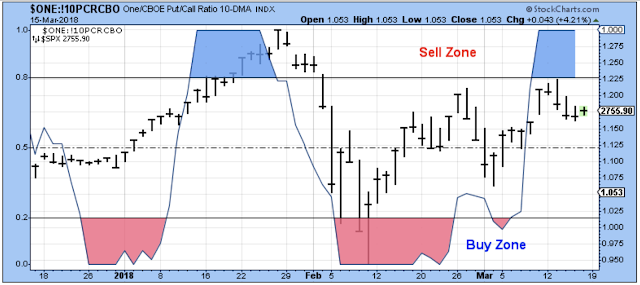The Investor’s Intelligence Newsletter Writers Sentiment Survey shows this week’s percentage of bullish advisors close to the 55% threshold. When the percentage gets above this level, the bullish sentiment works against stock prices. (This is an excellent sentiment survey, and has worked really well for me for years.)
I don’t think a high percentage of bulls means sell, but I do think the survey favors a freeze on new purchases in the short-term.
Below is a chart of the SPX with an overlay of the 20-day Stochastic RSI of the inverted put/call. (How ridiculous! And when are they just going to create a call/put ratio?). It is kind of cool, though, and it does a decent job of showing the general buy or sell zones (I generally think of a sell zone as a time to “not buy” rather than to actually sell. Again, kind of ridiculous, but I think you get it).
This chart generally agrees with Newsletter Writers Sentiment Survey in that it is probably best to refrain from too many new purchases for the time being, and wait until the RSI indicator is in the red again.
Of course, you know this kind of sentiment analysis only works as long as the longer-term outlook is generally favorable for the stock market. Also, it is of limited usefulness when the bull market is ticking consistently upwards such as last year when sentiment analysis seemed almost irrelevant.

I like to look at this chart to remind myself that these sell offs and spikes in the VIX are usually (not always!) a good time to be buying stocks rather than freaking out and selling.
I freak out sometimes. I admit it. But it is usually when I have started selling into a rally too soon, and then the cash burns a hole in my pocket and I start buying again too soon which is usually just when the uptrend is peaking.
If I stick to my discipline, I don’t freak out and I do well.

Outlook Summary:
Higher rates are now a headwind for US stocks. The recent tax cut, the 300 billion spending increase, and the already out-of-control federal deficit are a set up for a very dangerous spike in interest rates.














Leave A Comment